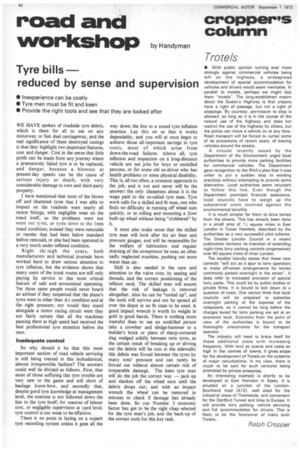road and workshop
Page 48

If you've noticed an error in this article please click here to report it so we can fix it.
by Handyman
Tyre bills reduced by sense and supervision
• Inexperience can be costly • Tyre men must be fit and keen • Provide the right tools and see that they are looked after WE HAVE spoken of roadside tyre debris, which is there for all to see on any motorway or fast duel carriageway, and the real significance of these destroyed casings is that they highlight two important features, cost and danger. Cost in the sense that little profit can be made from any journey where a prematurely failed tyre is to be replaced, and danger, because a blowout at present-day speeds can be the cause of serious injury or death, with very considerable damage to own and third-party property.
I have mentioned that most of the blown off and shattered tyres that I was able to inspect on the roadside were nearly all recent fittings, with negligible wear on the tread itself, so the problems were not worn out tyres, or tyres down to the lmm tread condition; instead they were remoulds or resoles that had been below standard before remould, or else had been operated in a very much under-inflated condition.
Right thr )ugh the years, both manufacturers and technical journals have worked hard to draw serious attention to tyre inflation, but the evidence shows that many users of the trunk routes are still only paying lip service to this most critical feature of safe and economical operating. Yet those same people would never board an airliner if they suspected that the plane's tyres were in other than Al condition and at the right pressure; nor would they stand alongside a motor racing circuit were they not fairly certain that all the machines passing them at high speed had received the best professional tyre attention before the race.
Inadequate control So why should it be that this most important section of road vehicle servicing is still being treated in this lackadaisical, almost irresponsible fashion? The answers could well be divided as follows. First, that most of those suffering this tyre trouble are very new to the game and still short of haulage know-how, and secondly that, despite good tyre knowledge at management level, the exercise is not followed down the line to the tyre itself; for reasons of labour cost, or negligible supervision at yard level, tyre control is too weak to be effective.
There is no point in laying on a superb tyre recording system unless it goes all the way down the line to a sound tyre inflation practice. Lay this on so that it works dependably, and you will at once begin to achieve those all-important savings in tyre costs, most of which arise from down-the-road failures. Above all, tyre inflation and inspection on a long-distance vehicle are not jobs for boys or unskilled persons, or for some old ex-driver who has health problems or some physical disability. This is, all too often, a common approach to the job, and is not and never will be the answer the only cheapness about it is the wage paid to the so-called tyre man. Tyre work calls for a skilled and fit man, one who finds no difficulty in running off wheel nuts quickly, or in rolling and mounting a 2cwt built-up wheel without being "clobbered" by it.
It must also make sense that the skilled tyre man will look after his air lines and pressure gauges, and will be responsible for the welfare of lubrication and regular draining of the compressor he uses, an often sadly neglected machine, pushing out more water than air.
Skill is also needed in the care and attention to the valve core, its seating and threads, and the correct positioning of the inflator neck. The skilled man will ensure that the risk of leakage is removed altogether. Also he can be "tooled up", and the tools will survive and not be spread all over the depot in no fit state to be used. A good impact wrench is worth its weight in gold in good hands. There is nothing more wasteful than to see an unskilled person take a crowbar and sledge-hammer to a builder's brick or piece of sharp-cornered slag wedged solidly between twin tyres, as the certain result of breaking up or driving out the debris will be cuts in the sidewalls; this debris was forced between the tyres by many tons' pressure and can rarely be forced out without almost certain risk of irreparable damage. The keen tyre man will do the job the correct way — jack up and slacken off the wheel nuts until the debris drops out ; and with an impact wrench the wheel can be removed in minutes to check if damage has already been done. So our Number 3 economy factor has got to be the right chap selected for the tyre man's job, and the back-up of the correct tools for this key task.


































































































